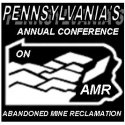Scranton, PA – Today, U.S. Representative Matt Cartwright (PA-08) joined the Lackawanna River Conservation Association (LRCA) and the Eastern Pennsylvania Coalition for Abandoned Mine Reclamation (EPCAMR) as they announced $50,000 federal awards they each will receive to fund projects that will mitigate the effects the anthracite mining industry has had on the region’s watershed and ecosystems and to offset costs thrust on local communities.

Congressman Matt Cartwright joins EPCAMR in congratulating our regional organizations in obtaining $50,000 in NFWF Federal Funding to assist in planning, assessing, and working towards the restoration, assessing areas for the removal of sediments and coal silts, identifying stormwater management issues, and assessing eastern brook trout and American black duck habitat for wildlife habitat improvements projects.
“When mining companies picked up and left Northeastern Pennsylvania, they weren’t held accountable for polluting our rivers and streams, and they left our communities to pick up the tab,” said Cartwright, a member of the House Appropriations Committee. “I don’t believe our friends and neighbors should be on the hook financially for a problem they didn’t create. It’s why I’ve always fought hard to boost funding for initiatives like the Chesapeake Bay Program, money that is being put to work to help dedicated advocates like LRCA and EPCAMR clean up the pollution and restore our communities to new glory. These resources will allow for more projects that will leave a legacy of clean water and air for generations to come while lessening the burden on homeowners in our area today.”

Bernie McGurl, Executive Director of the Lackawanna River Conservation Association (LRCA) talks about the Leggett’s Creek greenway and stream restoration planning project.
“We are very pleased with the opportunity to fully develop the greenway and stream restoration plans for this stretch of Leggetts Creek. We will finish construction designs and permitting for a number of projects to begin stream channel restoration, address the impacts of coal mining and urban stormwater, and design recreational trail and stream access sites to enhance the quality of life for neighborhood residents and visitors. We expect to make progress on a range of projects that we will continue to build upon in the years ahead to bring about the restoration of this reach of Leggetts Creek,” said Bernie McGurl, Director of LRCA.
“EPCAMR is looking forward to assessing these historic mining-impacted watersheds along the eastern flank of the Southern Wyoming Valley in partnership with the local governments, community partners, and wildlife and conservation organizations,” said Bobby Hughes, Executive Director of EPCAMR. “We will develop recommendations and a plan following the assessment and monitoring within these watersheds that will lead to future implementation projects that will help our communities to reclaim, remediate, and restore areas that are critical to improving the old infrastructure, improve the water quality locally, and eventually the Susquehanna River and the Chesapeake Bay.”

Bobby Hughes, EPCAMR Executive Director explaining to the audience at the Nay Aug Avenue Natural Playground Pavilion the scope of the work that will be completed along the watersheds on the eastern flank of the Southern Wyoming Valley using a Geographic Information Systems (GIS) watershed map created by his staff.
“After nearly 200 years of mining impacts to Northeastern Pennsylvania, worthy projects like this will receive important funding. This funding helps us better understand where our polluted waters are and how they can be cleaned up. Most importantly, these projects present potential opportunities for recreation and economic development, so important for the future of our region,” said Jacqui Bonomo, President & CEO of PennFuture.

Jacqui Bonomo, President & CEO of PennFuture speaks at the press event to highlight the great work that EPCAMR and LRCA are doing in NE PA. PennFuture, LRCA, and EPCAMR are all members of the PA Choose Clean Water Coalition, who are many of the 250 leading environmental groups within the Chesapeake Bay Watershed from multiple states who advocate and work towards having clean water within the Chesapeake Bay Watershed, a National Treasure.
As part of the fiscal year 2020 appropriations process, Cartwright successfully increased funding for the Chesapeake Bay Program by $12 million, to a total of $85 million in Fiscal Year 2020. That included a $6 million increase to the Small Watershed Grants Program, for a total of $18 million in FY2020, which is funding the projects that LRCA and EPCAMR will oversee and manage. These federal programs aim to improve the water quality and habitats of the Chesapeake Bay and its tributaries through the Small Watershed Grants (SWG) programs. They also can help lessen the burden on homeowners, who often have to pay “stormwater fees” imposed by municipal governments as the Commonwealth works to meet its obligation to restore our watershed.
The Leggetts Creek Greenway Project, managed by LRCA, addresses environmental concerns such as a compromised ecosystem lacking in biodiversity caused by the region’s anthracite coal mining and commercial residential development. The funds will be used to install bank stabilization measures, manage stormwater runoff, and run a monitoring and management program to maintain project efficiency.
EPCAMR will use its grant to fund their initiative, the Wyoming Valley Chesapeake Bay Tributary Field Assessments and Monitoring. The project will recruit volunteers to aid in restoring local natural resources impacted by past mining and provide hands-on field training and observation skills to identify sedimentation, stormwater, and aquatic organism passage in the Wyoming Valley. They also plan to develop and recommend conservation, watershed, and habitat management plans and implementation projects to guide landowners, organizations, and local governments in restoring areas for successful conservation outcomes.
The awards are distributed through the Environmental Protection Agency (EPA) and awarded by the National Fish and Wildlife Foundation (NFWF).













You must be logged in to post a comment.